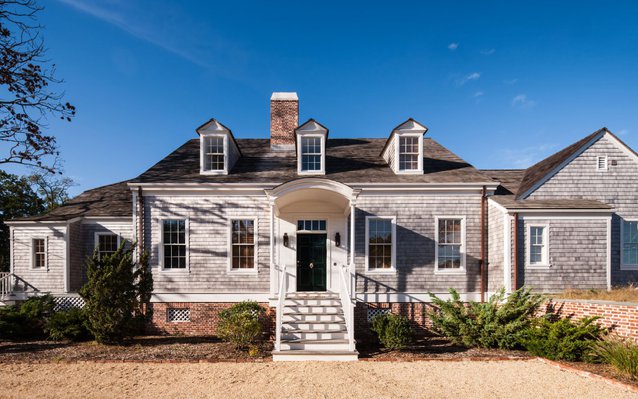Ocean Home "Masterpiece Classic"

Out on the east end of Long Island, N.Y., above a challenging patch of land overlooking Little Peconic Creek, stands a modest cedar shingled Cape Cod cottage in the 18th-century style. This one, however, is a newcomer.
Completed in 2012- and designed to fit in the home is based on a five-hay cottage with a center chimney, standard yeoman’s fare from centuries past in New England. Its earliest ancestors likely hailed from Cornwall in England, where slate was the shingle of choice rather than Southampton cedar. “There’s no stone out there, and very little clay, so brick would not have been an option,” says architect Richard Sammons. “White cedar, pine, and scrub oak are your materials.
A partner in the renowned firm of Fairfax & Sammons, with offices in New York City and Palm Beach, Fla., he should know. For the past three decades, Sammons has been building a reputation as one of the finest classical architects practicing today- if not the best. “He grasps and channels many of the great architects we admire,” says Steven Semes, associate professor and director of the graduate program in historic preservation at the University of Notre Dame. “He looks back to Thomas Jefferson in Virginia and forward to Philip Shutze in Atlanta, but he doesn’t repeat them. He extends the vocabulary and language they used.”
Sammons found his inspiration for this little house in nearby homes like Miss Amelia’s Cottage, built-in 1725 on Amagansett, and now open to the public. “It’s very similar to that- they’re very common, and all over the place,” Sammons says.
He has also worked on vernacular buildings in the region, like Pi Gardiner’s 1750 shingle-style home in Quogue, where he expanded the kitchen and added a pergola outside. “It’s stunning and in perfect proportion to the house,” Gardiner says. “You look at it, and it works= there’s a visceral feeling that’s almost tangible.”
For this cottage, Sammons’ assignment came from client Peter Malt, a native of Germany who’s been spending summers in Southampton since 1985. Malt’s request was to build a home for his daughters, next door to his own home 600 yards away. He’d already purchased and merged three lots into one, but even so, the site for this 4,200 square-foot home was tight.“Since the property is partly wetlands and in a flood zone, more than 50 percent of the land was declared a ‘non-disturbance zone,’ making planning even more complicated,” says Malt.
“It’s kind of a miracle to get so much house in such a small lot,” says Rob Morris, project architect at Fairfax & Sammons. On top of that FEMA regulations required that it sit four feet off the ground, resulting in a home that’s built atop a brick-on-block foundation. “It steps up,” says Sammons, “but we had to make it look natural, and not seen to be sitting up on stilts.”
Still, it seems at home in its neighborhood, which was absolutely the architect’s intent. Sammons favors a regional response for any building he designs, aiming to place it at ease within its context. The idea is to make it look as though it’s always been there, even if it hasn’t.
“If I’m building in Ohio, I’d be looking at Federal and Greek Revival,” he adds. “I always want to add a piece that makes the place more like a place, rather than less of a place. The question is: How does it add up with its neighbors?”
The answer for this home in Little Peconic Creek? Remarkably well. The exterior’s white-cedar shingles have weathered to a shimmering gray that recalls the small harbor and boatyard down the street, and it’s scaled to match up to older cottages nearby, built in the 1920s and ‘30s.
“The assignment was to make a house that’s completely in keeping with the history and context of Long Island, as well as something that’s snug,” Sammons says. “It’s very Spartan because the clients are very Spartan.”
The home is a three-bedroom, four-bath affair with the master on the ground floor and two bedrooms above. Also on the first level are a dining room, living room and, off the back, a terrace with a swimming pool.
The form of the from door’s Federal-style canopy is repeated rhythmically over a screened porch at the rear, where a picture window opens the home up to sweeping waterfront vistas. “It overlooks the bay and one of the great seafood estuaries on the East Coast, full of scallops and oysters,” Sammons says.
All of it clearly demonstrates the touch of a designer who knows how to achieve harmony in relationships between people and the built environment. “He’s a master of proportion among architects today,” says Semes. “He thinks about it as he’s designing, and he works the same was architects did years ago, with a very deep understanding of geometry.
A master draftsman, Sammons draws most of the details for his houses at full size, working out issues in his mind and on paper as he moves along. The working drawings are then sent along to artisans and craftsmen for execution. “That’s another way he manages to control the proportions,” Semes says. “If you study the details at full size, it’s easier to get them right.”
Sammons estimates that his firm, now 20 people strong, has designed and built more than 60 homes since it was established in 1991. Most are located in New York and along the East Coast, although the firm’s reach now extends as far as Hong Kong, Israel, Switzerland and Great Britain.
In Palm Beach, he’s currently working on a home designed by Addison Mizner, the gifted architect whose well-proportioned Mediterranean and Spanish Revival designs for 1920s Florida would come to define places like Boca Raton. “It’s a house he designed for himself,” says Sammons. Chances are, Mizner would approve of the architect now engaged with his home. After all, before he moved to Florida from New York in 1918, he too was designing country houses for well-heeled clients who spent their summers out on the waters of Long Island. Which makes it all a good fit.
SEE THE WORK


